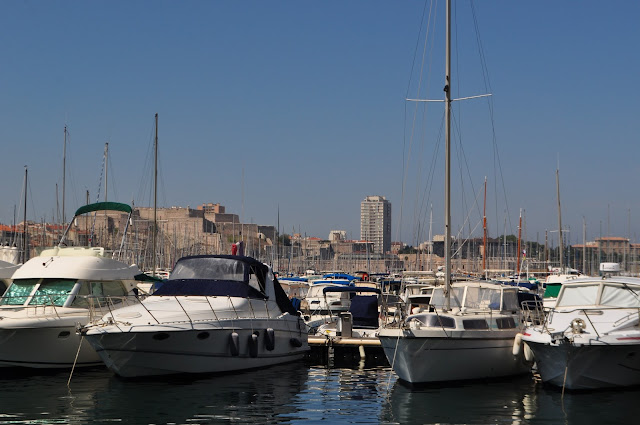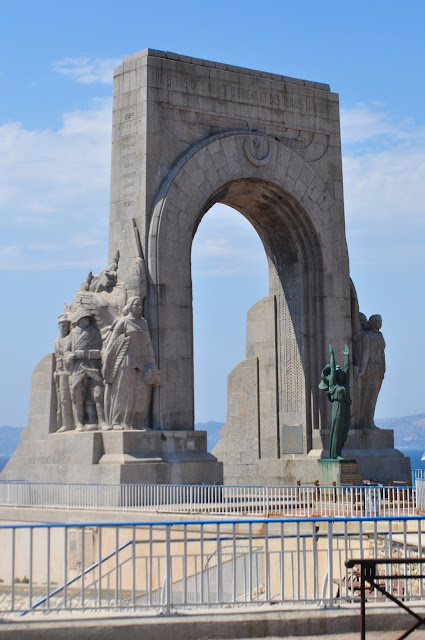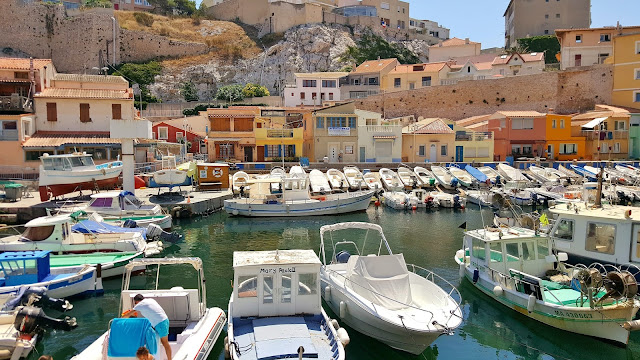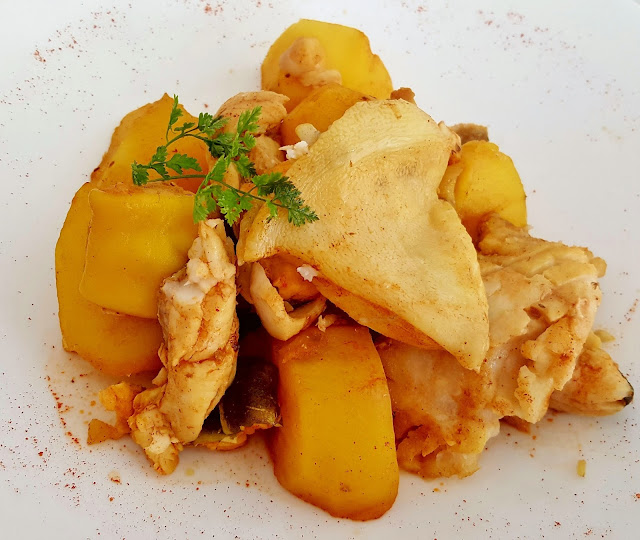We had been talking about throwing a Provence Party in our backyard with a traditional Bouillabaisse for some time. We had even told the neighbors it would take place in August when we returned from Sablet. While we were in Provence, I wanted to go to Marseille and have a Bouillabaisse in one of the restaurants renown for the dish and see how it is presented to diners.
Despite having multiple "French Connections" to Marseille, we don't go very often (traffic is a mess and parking hard to find among other reasons). My connections include my father and family lived on Boulevard Longchamp in Marseille when he was growing up and cousins lived in Marseille with their families too at various times. Now, cousins Ginette and Josiane live there. I digress so let me get back to the topic at hand.
As the time was nearing for us to leave Sablet, we set a date to meet up with Ginette for a traditional Bouillabaisse and go shopping for our daughters. Marseille's Vieux Port is about one hour and thirty-five minutes down the A-7 from Sablet. We found parking near the Town Hall and walked around the Vieux Port from the north side to the south side to shop before we went to lunch. On the way to and from our car, we saw the sights shown in the photographs which follow.
By way of background I should mention that
Marseille was founded by the Phoceans (from the Greek city of Phocaea, now Foça, in modern Turkey) in 600BC and is one of the oldest cities in Europe. The town is a far cry from the Cézanne paintings and Provençal clichés of sleepy villages, "pétanque" players and Marcel Pagnol novels.
 |
| Marseille's Notre Dame de la Garde |
With around one million inhabitants, Marseille is the second largest city in France in terms of population and the largest in terms of area. The people of Marseille have varying ethnic backgrounds, with a lot of Italians and Spanish having immigrated to the area after the second world war. Currently, over one third of the population of Marseille can trace their roots back to Italy.
 |
| Marseille's Vieux Port |
Everything in Marseille revolves around the U-shaped Vieux Port (Old Port) in the center of the city where boats have docked for 2600 years. The port is more pleasure marina that working port these days with pleasure yachts, small fishing boats, and sailboats filling more than 10,000 slips.
 |
| Marseille's Vieux Port |
Around the port, fishermen mend their nets and lounge on benches reading newspapers in Greek and Arabic while cafes and restaurants serve up seafood from the nearby Mediterranean Sea.
 |
| Marseille street with nice shops |
The Saint-Ferréol les Augustins Church is a Roman Catholic church located on Marseille's Vieux Port. The original building was owned by the Knights Templar. However, in 1369, it was given to a community of Augustinian hermits. By 1447, they spearheaded construction of a new church building. It was dedicated in 1542, even though the roof was not finished until 1588.
Pope Clement VII married his niece, Catherine de' Medici, to Henry II of France, in this church on October 28, 1533
 |
| Saint-Ferréol les Augustins Church |
Le Panier quarter - the bread basket, seen below is one of Marseille's oldest sections. Le Panier is only a small part of what used to exist before the Germans dynamited it during World War II to flush out the Jews and Resistance fighters hiding there.
Up until the 1970s, the Le Panier quarter was the center for purification of heroin that passed through Marseille to Europe and the United States, hence the "French Connection" depicted in the 1971 movie starring Gene Hackman. Today ancient buildings line narrow back streets - kids playing, laundry flapping and people chatting in the squares.
 |
| Le Panier |
 |
| Shops along the Vieux Port |
The Marseille City Hall (Hôtel de Ville) seen below was built between 1653 and 1673. It was one of the few buildings on the harbor to survive the destruction of World War 2.
 |
| Marseille Town Hall |
The ferris wheel seen below is located on the east end of the Vieux Port. While I am sure the view from the top of the ride over the port, the sea and the city of Marseille is nothing short of spectacular, my fear of heights will probably keep me from ever seeing those views from the ferris wheel.
 |
| Ferris wheel at Marseille's Vieux Port |
After concluding our shopping, we decided to take a taxi to the restaurant in order to avoid having to deal with the Marseille traffic. Restaurant Fonfon is located in the Vallon des Auffes near the Monument aux Morts de l'Armée d'Orient off the Corniche du President-John-Fitzgerald-Kennedy.
The Monument aux Morts de l'Armée d'Orient by Antoine Sartorio seen below stands on a rocky promontory on Marseille's seafront and remembers all those Frenchmen who gave their lives during the 1914-1918 war fighting overseas particularly in the Far East.
The center of the arch has a carving of a crescent and a star. Sculptures of air force personnel and soldiers stand on one side of the arch together with a winged angel whilst on the other side is another winged angel and on a pedestal in the center of the arch is a bronze "angel of victory" her arms lifted to the skies. A stairway leading down to the sea completes the memorial.
 |
| Marseille War Memorial called "Monument aux Morts de l'Armée d'Orient" |
Fonfon Restaurant which has been in business since 1952, is located in Vallon des Auffes, a small picturesque fishing port crowded with "pointus", traditional fishing boats and ringed by "cabanons", fishing sheds in Marseille's 7th arrondissement.
 |
| Vallon des Auffes |
 |
| Vallon des Auffes" |
Marseille is most famous for three things: the national anthem called “La Marseillaise”, the "French Connection" drug trade and bouillabaisse. Of these, the renowned fish stew of Provence is easily the most controversial and complicated. For a start, no one can even agree on the origin of the actual word, let alone the origins of the dish.
The most likely story is that it came about when local fishermen decided to boil up the fish and crustaceans they couldn't easily sell, which explains why the main contents are small rock fish and other ugly ducklings of the Mediterranean coastline, such as rascasse and anglerfish.
The prime ingredient is at least one of the three members of the rascasse family. The other commonly accepted ingredients are olive oil, onions, garlic, tomatoes, fennel, parsley and saffron. Some add a glug of Pastis, the anise-flavored aperitif.
 |
| Fonfon Restaurant |
Recommended wines for bouillabaisse are Provencale rosés, and white wines from Bandol, Cassis and the Rhone. We opted for a bottle of white Clos Sainte Magdeleine, one of our favorite wineries in Cassis that I told you about
here.
 |
| Clos Sainte Magdeleine |
As is the custom, our server brought a platter to the table to show the fish that would be cooked for our Bouillabaisse that day. Most recipes call for bouillabaisse to include at least five types of fish. It almost always contains rascasse, a Mediterranean fish. The addition of shellfish is voluntary and is seen as snobbish by many Bouillabaisse purists.
 |
| Server presenting fish that will be cooked for the Bouillabaisse |
Shirley finds the fish soup that is served for Bouillabaisse to be a little strong for her liking. So she opted for having one of Sole the server presented cooked to order for her. Whole fish is sold per 100 grams.
 |
| Tray with choices of whole fish for the day |
 |
| Amuse Bouche |
Bouillabaisse comes in two courses. First is the soup, accompanied by croutons, which you rub with a clove of whole garlic and spread with rouille, a bright orange mayonnaise flavored with saffron, cayenne and more garlic (rouille means, literally, "rust").
 |
| Bouillabaisse soup |
The second course is the fish themselves, which are usually presented whole on a platter before they are taken back to the kitchen to be cooked and filleted for diners. The cooked fish are usually accompanied by potatoes that have been cooked in the Bouillabaisse soup.
 |
| Cooked fish for Bouillabaisse |
 |
| Perfectly cooked Sole. |
 |
| We chose ice cream for dessert |
The Bouillabaisse was excellent. One thing I noticed was that from the last time I was there about 7 years ago, the clientele had changed from all French speakers to mostly tourists at least on this particular day. We headed back up to the Corniche and hailed a taxi to return to our car.
 |
| Vieux Port with Notre Dame de la Garde in the distance |
It is very hard to find well-prepared, traditional Bouillabaisse in Provence. Forget one that is cheap. If you do find one that is cheap, don't order it. If you visit the fish mongers in the South of France, you know how expensive fresh fish is. So it stands to reason that an excellent traditional Bouillabaisse will be quite expensive. Chez Fonfon's menu currently quotes a price of 53 Euros per person.
Chez Fonfon Restaurant
140 Rue du Vallon des Auffes
13007 Marseille
Tel: 04 91 52 14 38
website: www.chez-fonfon.com



















